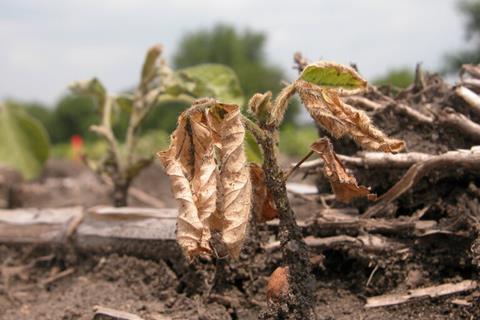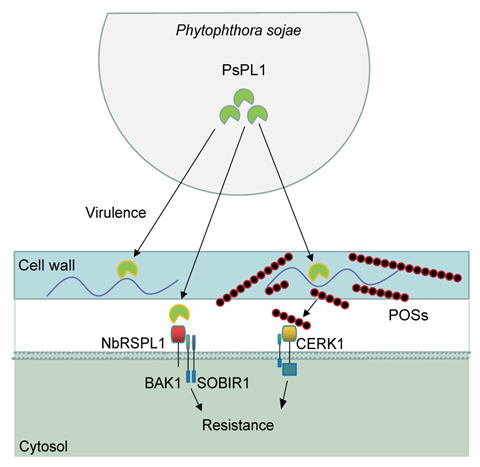The plant cell wall is composed of complex polysaccharides, including cellulose, hemicellulose, and pectin, and serves as an effective physical barrier against microbial pathogens. To successfully infect host plants, pathogens produce various cell wall-degrading enzymes to degrade the cell wall, enabling them to penetrate host cells and spread throughout the plant.

Pectin is a polysaccharide of α-1-4-linked galacturonic acid residues that are heavily decorated with methyl and/or acetyl groups and can be degraded by a series of plant pathogen-secreted pectin-degrading enzymes such as polygalacturonase (PG, EC3.2.1.15), pectin methylesterase (PME, EC 3.1.1.11), pectate lyases (PELs, EC4.2.2.2), and pectin lyases (PLs, EC4.2.2.10, EC4.2.2.2).
Research has shown that most pectin-derived oligosaccharides are methylesterified and acetylated during plant-pathogen interactions, with 80% being generated by PLs and 20% by PGs. PLs cleave the α-1,4 glycosidic bonds inside pectin via a β-elimination reaction. However, due to the complexity of the substrates for PL enzymes, the precise role of PLs in the interaction between pathogens and plants remains unclear.
Physiological cell death
This study, published in Science China Life Sciences, found that the pectin lyase PsPL1, secreted by Phytophthora sojae, could induce physiological cell death in plants, with this cell death occurring independently of BAK1 and SOBIR1. Overexpression of PsPL1 in P. sojae leads to the production of reactive oxygen species (ROS) in soybean, which in turn inhibits the infection of P. sojae. Researchers found that PsPL1 protein could trigger immune responses in soybeans, including ROS burst and the upregulation of defense-related genes, with these responses also partially relying on its enzyme activity. The immunity induced by PsPL1 in plants is contingent on BAK1 and SOBIR1. Furthermore, they identified an LRR-RLP protein, RSPL1, which interacts with PsPL1, as a key regulator of PsPL1-induced immune responses and plant resistance against Phytophthora.

Due to the partial dependence of plant immunity induced by PsPL1 on its enzyme activity, researchers employed high-performance anion exchange chromatography (HPAEC-PAD) and liquid chromatography-mass spectrometry (LC-MS) to identify the degradation products of plant pectin by PsPL1.
The resulting products were pectin oligosaccharides with methylation and/or acetylation modifications, and polymerization degrees ranging from 3 to 14. These pectin oligosaccharides were found to induce immune responses and disease resistance in soybeans by activating the plant cell membrane LysM protein kinase CERK1, bypassing regulation by LRR proteins. This suggests that both PsPL1 protein and its degradation products possess the capacity to activate plant resistance through recognition by distinct types of cell membrane receptors.
Role of pectinase
This study elucidates the mechanism by which pectin lyase activates plant immunity, thereby offering a theoretical foundation for further exploration of the role of pectinase in pathogen-plant interactions. It also advances research into the underlying mechanisms governing plant-microbe interactions.

Nanjing Agricultural University is the primary affiliation for this paper, with Drs Guangzheng Sun and Yeqiang Xia from Nanjing Agricultural University serving as co-first authors. Profs Yuanchao Wang and Yan Wang from Nanjing Agricultural University, along with Professor Heng Yin from the Dalian Institute of Chemical Physics, Chinese Academy of Sciences, are co-corresponding authors. This study was supported by several projects, including the Natural Science Foundation of Jiangsu Province and the Fundamental Research Funds for the Central Universities.
The crop disease research team led by Professor Yuanchao Wang has investigated the complex multimolecular interactions between pathogenic oomycetes and plants at the host cell wall. Their work revealed a novel pathogenic mechanism termed the “decoy mode”. In collaboration with Prof. Jijie Chai, they uncovered that the cell membrane receptor protein RXEG1 served dual roles as both an “immune receptor recognition” and “enzyme activity inhibitor”. They also elucidated the molecular mechanism by which the plant polygalacturonase inhibitor protein PGIP specifically binds to pathogenic polygalacturonase PG, hijacking its enzyme activity to generate long oligogalacturonides (OG10-15), which induce plant disease resistance. These findings offer theoretical and practical insights for understanding the interactions between plants and pathogens, as well as for enhancing the long-lasting and broad-spectrum disease resistance of plants.







No comments yet